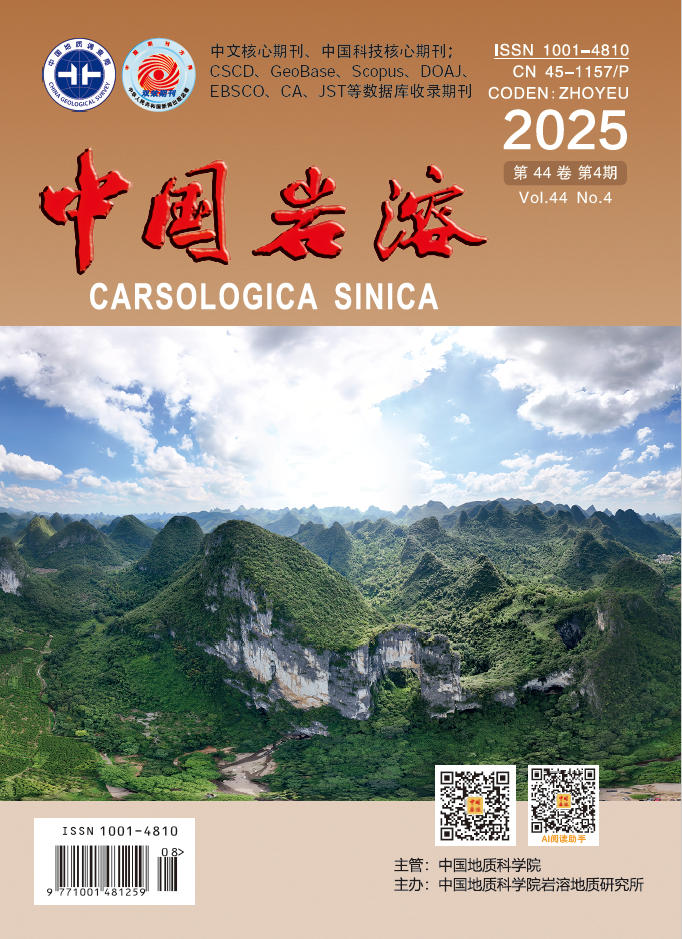2024, 43(3): 575-584.
doi: 10.11932/karst2024y021
Abstract:
The travertine profiles are located in the Zhaga waterfall in Munigou, Sichuan Province, where the highest altitude ranges from 4,070 m to 2,800 m, and the average annual temperature is 7℃. The study area is situated in the Minjiang fracture zone, with Paleozoic carbonate construction on the east side of the fracture, and shallow metamorphic rocks and slates of the Middle and Upper Triassic Xikang Group on the west side. Travertine is deposited by the stream fed by karst springs, and the mouth of the spring is located on the left bank of the hook upstream of Zhaga waterfall. The travertine deposits are distributed from the mouth of the spring down to the mouth of the gully. Their depositional patterns fall into striated travertine, clastic travertine, etc., and the type of depositional phase is a dam. The overall travertine profile is about 30-meter thick with horizontal sedimentary construction. In this study, the travertine profiles were investigated in terms of mineralogy and isotope geochemistry. UV spectrophotometry and X-ray fluorescence spectroscopy were used to determine the organic matter, total nitrogen, total phosphorus and chemical elements in travertine profile sediments so as to comprehensively analyze the characteristics of the travertine profiles and their significance of environmental indications. The results show that the travertine profiles can be divided into four stages based on sedimentary features such as sediment color, texture and inclusions. Stage 1: 1,080–1130 cm, overall dominated by a black muddy travertine layer interspersed with yellow travertine, grey travertine, and white travertine, containing twigs, leaves, and roots; Stage 2: 1,130–1,230 cm, overall dominated by a grey travertine layer interspersed with yellow travertine and black muddy travertine layers containing tree roots; Stage 3: 1,230–1,353 cm, overall dominated by yellow travertine layers interspersed with black muddy travertine, white travertine and grey travertine; Stage 4: 1,353–1,480 cm, overall dominated by a white travertine layer interspersed with yellow travertine and black muddy travertine layers containing roots and leaves.The testing and analysis of the sediments from the travertine profile in Munigou revealed that the overall organic matter content of travertine sediments ranged from 294.66 g·kg−1 to 2,366.52 g·kg−1 with a mean value of 1,031.93 g·kg−1; the TN content ranged from 0 g·kg−1 to 0.89 g·kg−1 with a mean value of 0.25 g·kg−1; the TP content ranged from 0.03 g·kg−1 to 0.25 g·kg−1 with a mean value of 0.12 g·kg−1. In order to fully understand the relationship between organic matter, TN and TP, and to better reveal the environmental characteristics when the travertine was deposited, we carried out Pearson correlation analyses of organic matter, TN and TP, which showed that the organic matter and TN content exhibited a significant correlation (r=0.822, n=48, P<0.01); the organic matter and TP content were positively correlated (r=0.574, n=48, P<0.01); there was a good correlation between TN and TP contents (r=0.644, n=48, P<0.01). Travertine sediments with four different colors at different depths were selected for elemental analysis, and the results showed that the main chemical compositions of the travertine profile were CaO and SiO2, followed by Al2O3, Fe2O3, MgO, Na2O, and TiO2. The CaO content ranged from 97.79% to 27.51%, with an average value of 70.25%. The SiO2 content ranged from 50.10% to 0.76%, with an average value of 19.52%. CaO is chemically active and easy to migrate. The high CaO activity indicates that it is easily lost under warm and humid conditions, making its content relatively low, and under dry and cold conditions, the weak surface chemical action enriches CaO, making its content high. SiO2 is chemically stable and difficult to migrate; therefore, its high content can indicate much precipitation, warm and wet climate, and its relatively high enrichment, and vice versa.The travertine profiles at 1,080–1,130 cm, 1,250–1,280 cm and 1,460–1,480 cm were dominated by black muddy travertine, with high content of organic matter, TN and TP, and their chemical elements were dominated by SiO2. The environment at the time of travertine deposition is presumed to be of wet climate during the rainy season with abundant precipitation. The travertine profiles at 1,130–1,250 cm and 1,280–1,460 cm were dominated by grey travertine, white travertine and yellow travertine, with low levels of organic matter, TN, TP, and their chemical elements were dominated by CaO. The environment at the time of deposition is presumed to be of a dry season with little precipitation and dry and cold climate. The above conclusions are intended to reveal the environmental conditions of Munigou at the time when travertine was deposited and to lay the foundation for an in-depth study of the ancient environment of Munigou.






